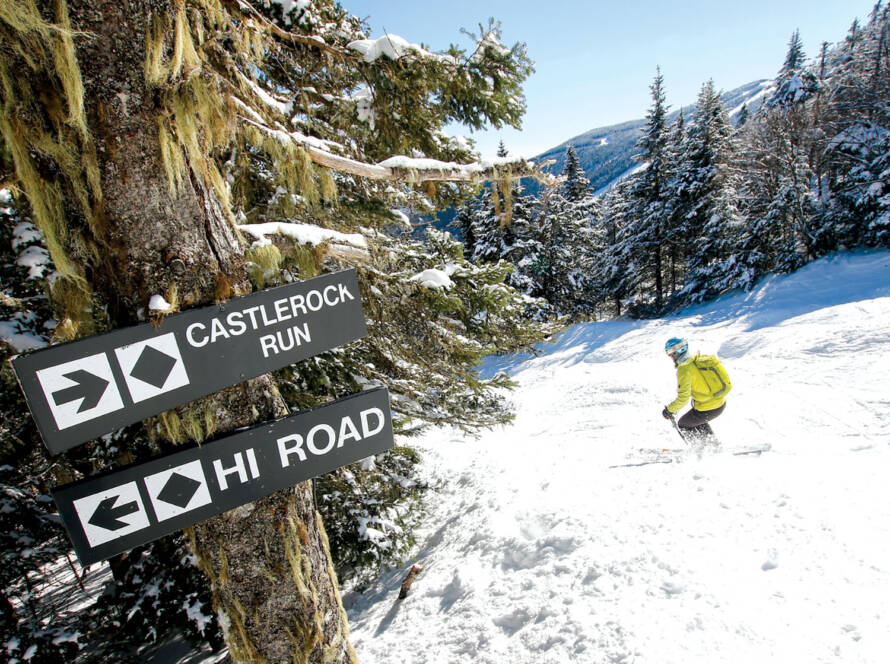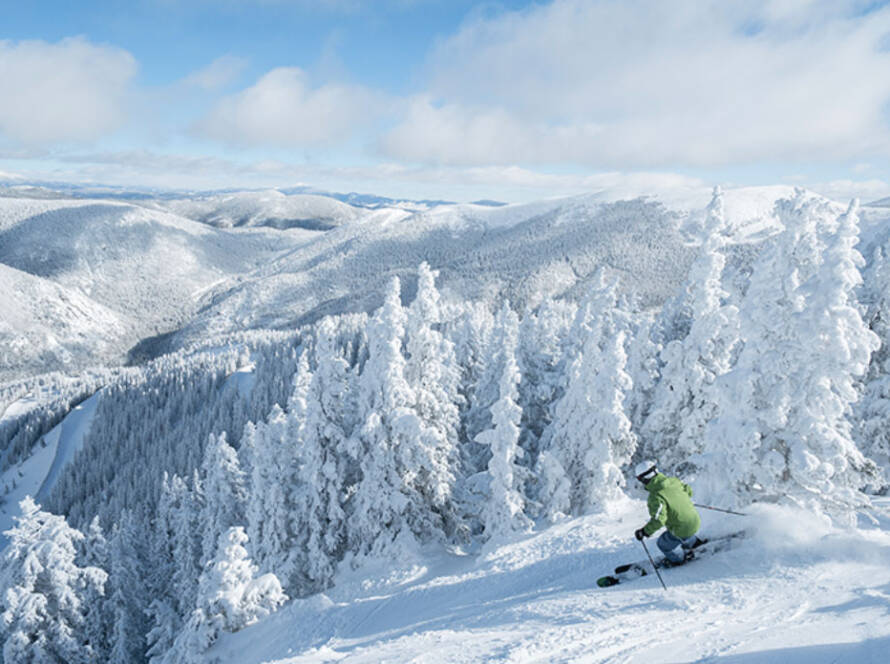Tucked deep in the Rogue River-Siskiyou National Forest in southern Oregon, Mt. Ashland Ski Area has been attracting skiers for more than 50 years, inspiring a level of loyalty and passion that has overcome many obstacles threatening its very existence.
At 7,532 feet above sea level, Mount Ashland is the highest peak in the Siskiyou Range, the northernmost sub-range of the Klamath Mountain Range, stretching from the southwest corner of Oregon into northwestern California.
Local backcountry skiers had been enjoying the mountain’s challenging upper flanks during the 1940s and 50’s, and in 1963 they banded together to further develop roads, clear runs and install one chair lift, a T-bar and a rope tow on the north side of the mountain. At the base area, sitting at 6,383 feet – a vertical drop from the peak of about 1,150 feet – they built the lodge and parking area.
During the years that followed, the ski area changed hands several times, plagued by random years of low snowfall in the Mediterranean climate of southern Oregon. After a drought that lasted from 1988 to 1991, bankruptcy threatened. In an all-out grassroots effort to prevent closure, the local community raised $2 million to purchase the ski area and the non-profit Mount Ashland Association was created to maintain and operate the ski area.
Today, almost 30 years later, this thriving ski area has two triple chairlifts, two double chairs and a rope tow for the beginners’ area. From mid-December to late April, skiers can access 23 trails over 220 acres with 40 acres of those trails available for night skiing. The wide variety of terrain is further enhanced by The Bowl – a lift-serviced glacial cirque offering the challenge of steep chutes and tree skiing. Three recently added high-definition live-streaming webcams bring views of the slopes to anywhere in the world.
One hundred and thirty seasonal workers plus several full-time staff, many of them long-term senior team members with extensive lift experience on the mountain, keep the ski area running smoothly and efficiently. On “Slope Care Days” local volunteers assist the crews in trail trimming, erosion control and other beneficial efforts that give a sense of pride and ownership in the health and success of their local ski area.
Hiram Towle, general manager at Mt. Ashland credits this sense of community with having a very large part in making the area unique. “Mostly it’s the vibe, the close-knit community that welcomes visitors, and a highly competent and skilled staff. We get great reviews and I hear from guests every day that our crew is top-notch.”
A free shuttle service (the SNOW BUS) runs from the city of Ashland, about a half-hour trip up to the base of the mountain, while the recently expanded parking area serves the majority of visitors. There is no overnight accommodation on the mountain, therefore its designated as a ski “area” rather than a “resort,” but a partnership with lodging properties in nearby Ashland and Medford means visitors don’t have far to travel. As Towle points out that’s because the majority of tourists come to the area in summer, both centers are able to offer a wide range of pricing and availability in the winter months; better than the average “ski town” lodging experience.
The extensive ski school at Mt. Ashland offers learn-to-ski programs for skiers of all ages and although the terrain is balanced more towards advanced skiers and riders, the separate beginners’ area has been recently re-sloped so that everyone can enjoy a day on the mountain. A full-service rental and repair shop is available in the lodge along with retail space for all of the mountain provisions needed for a day on the slopes.
Two on-site food locations – the Granite Grill and the Balcony Bistro – deliver extensive menus ranging from gourmet to the traditional burger and fries. “In the lodge, the ‘T-bar’ is your classic ski bar filled with history and rustic charm,” said Towle. “Local beer graces the tap and the two shot skis are well used. It is the quintessential ski bar with [a] high ceiling, exposed beams and lots of stories of greatness being shared on any given day.”
The historic Tudor-style lodge, holding so many stories and memories from the past 56 years, had a $1.7 million renovation in 2017 that included upgrading the energy performance throughout the building. “The fact that we are a non-profit allows us to keep all our prices low for our guests, but it also means we are able to make such capital improvements through fund-raising,” said Towle.
Over six months, beginning in June, the main floor was completely re-arranged with another 1,000 square feet added for less congestion in the food service area while also relocating the rental shop to the ground floor for much easier access. High-speed WiFi now blankets most of the ski area, yet the lodge has kept its quirky, chalet style.
Looking to the Future
In May 2017, Mt. Ashland became the first STOKE Certified ski area in the country. Towle said, “Stoke is a sustainability management system, and with Stoke, it isn’t just the environmental piece. It includes more than 150 quantifiable measures and 300 indicators of sustainability specifically designed for the ski and snowboard tourism sector. Stoke-certified ski areas have developed comprehensive sustainability management plans that ensure they are protecting the areas you love to ride and the people that live there.”
The Mt. Ashland Ski Area had already been fulfilling these criteria for many years in its support of local businesses and involvement in local cultural activities and community events, effective disposal of liquid and solid waste, using available renewable energy sources whenever possible to reduce the carbon footprint and enforcing proper mountain safety without compromising riding creativity and progression. A comprehensive Stoke sustainable management plan gave further direction in leveraging even more sustainable practices into the life and operation of the ski area.
“Under the Stoke model, we have implemented a carbon-reducing free shuttle service, installed a 28 kilowatt solar system that offsets 12 percent of our electric use along with a myriad of
efficiency projects,” said Towle. “For example, LED lighting in our vehicle shop alone will save 8,000 kilowatt hours per year.”
In addition, Towle notes that the ski area purchases many local goods and services and hosts several community events including the annual Snow Blessing Ceremony that brings Indigenous people and folks from a half dozen religions together to celebrate the life-giving water that the snowfall releases to the pristine watershed of the Rogue River.
From the beginning, Mt. Ashland has been at the mercy of Mother Nature when it comes to snowfall – more so than many other ski areas as there is no adequate water source to support snowmaking. As a result of regular drought cycles, and the impact of global climate change, Mt. Ashland has stood on the precipice of closure many times.
However, true to its history of never giving up, the ski area has implemented creative solutions designed to help it stay open in those low snow years and financially difficult times.
“We have a business model that allows investment in the good years and incredibly efficient operations that still put money in the bank in the lean years,” said Towle. “We have adapted to shorter seasons and reduced snowfall – not that it happens all the time, mind you; we did have a 371-inch season in 2016/17!”
The ski area has added loading ramps at the lifts, farms snow from the parking lot using adapted equipment and utilizes a more aggressive slope management program that reduces the amount of snow needed to operate.
All of these efforts are making a noticeable difference. Towle explains that the ski area traditionally needed between 24 and 36 inches to operate depending on the quality of the snow, but that this 2018/19 season they opened a day ahead of target on only 21 inches of snow.
Capital plans for the coming summer include further low-snow prep such as installing snow fences, load/unload decks and slope trimming.
The ski area continues to work towards year-round operation and it does currently host events, weddings and an assortment of gatherings. “We would like to take the next step and develop a summer outdoor recreation offering that would include zip lines, rock-climbing walls and all the usual alpine attractions,” said Towle. “It may take a few years, but efforts are underway.”
With a forward-thinking, sustainable plan in place and a strong community dedicated to making it happen, the Mt. Ashland Ski Area is fulfilling its vision to be here today and for future generations.


